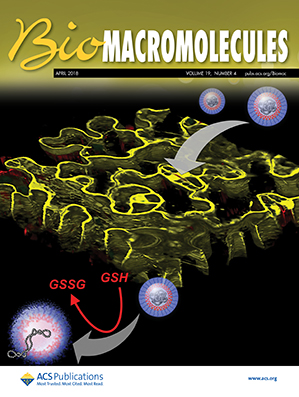In Vitro Evaluation of Gelatin-Based Hydrogels as Potential Fillers for Corneal Wounds
IF 5.5
2区 化学
Q1 BIOCHEMISTRY & MOLECULAR BIOLOGY
引用次数: 0
Abstract
Corneal persistent epithelial defects are common ophthalmic injuries that can cause significant visual and structural damage. While diagnosis is straightforward, treatment remains challenging. Noninvasive therapies like eye drops are preferred, but severe neurotrophic keratopathy may require surgical interventions. This study explores gelatin-based hydrogels as noninvasive alternatives for corneal repair. Four photo-cross-linkable hydrogels with gelatin and riboflavin phosphate (RFP) were evaluated: a control and variants incorporating 2.5% dextran (D), 0.4% hyaluronic acid (HA), or 1% methylcellulose (MC). In vitro assessments included physicochemical properties, biocompatibility, and release kinetics alongside ex vivo wound healing assays. The gelatin-RFP hydrogel maintained corneal transparency, while additives reduced it. Dextran slowed compound release, and HA and MC reduced the release rate of larger molecules. All hydrogels showed excellent biocompatibility, and ex vivo models confirmed re-epithelialization, though slower than controls. The unmodified gelatin-RFP hydrogel demonstrated the best potential for corneal tissue engineering, supporting its future clinical translation.
- Download: Download high-res image (132KB)
- Download: Download full-size image
明胶水凝胶作为角膜伤口潜在填充物的体外评估
角膜持续性上皮缺损是常见的眼部损伤,可引起严重的视觉和结构损伤。虽然诊断很简单,但治疗仍然具有挑战性。滴眼液等非侵入性治疗是首选,但严重的神经营养性角膜病变可能需要手术干预。本研究探讨以明胶为基础的水凝胶作为无创角膜修复的替代品。评估了四种具有明胶和磷酸核黄素(RFP)的光交联水凝胶:对照和含有2.5%葡聚糖(D), 0.4%透明质酸(HA)或1%甲基纤维素(MC)的变体。体外评估包括物理化学性质、生物相容性和释放动力学以及体外伤口愈合试验。明胶- rfp水凝胶保持了角膜透明度,而添加剂降低了透明度。葡聚糖减缓了化合物的释放,HA和MC降低了大分子的释放速度。所有水凝胶都显示出良好的生物相容性,离体模型证实了再上皮化,尽管比对照组慢。未经修饰的明胶- rfp水凝胶显示出最佳的角膜组织工程潜力,支持其未来的临床转化。
本文章由计算机程序翻译,如有差异,请以英文原文为准。
求助全文
约1分钟内获得全文
求助全文
来源期刊

Biomacromolecules
化学-高分子科学
CiteScore
10.60
自引率
4.80%
发文量
417
审稿时长
1.6 months
期刊介绍:
Biomacromolecules is a leading forum for the dissemination of cutting-edge research at the interface of polymer science and biology. Submissions to Biomacromolecules should contain strong elements of innovation in terms of macromolecular design, synthesis and characterization, or in the application of polymer materials to biology and medicine.
Topics covered by Biomacromolecules include, but are not exclusively limited to: sustainable polymers, polymers based on natural and renewable resources, degradable polymers, polymer conjugates, polymeric drugs, polymers in biocatalysis, biomacromolecular assembly, biomimetic polymers, polymer-biomineral hybrids, biomimetic-polymer processing, polymer recycling, bioactive polymer surfaces, original polymer design for biomedical applications such as immunotherapy, drug delivery, gene delivery, antimicrobial applications, diagnostic imaging and biosensing, polymers in tissue engineering and regenerative medicine, polymeric scaffolds and hydrogels for cell culture and delivery.
 求助内容:
求助内容: 应助结果提醒方式:
应助结果提醒方式:


